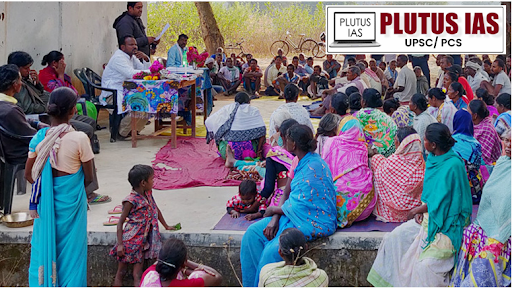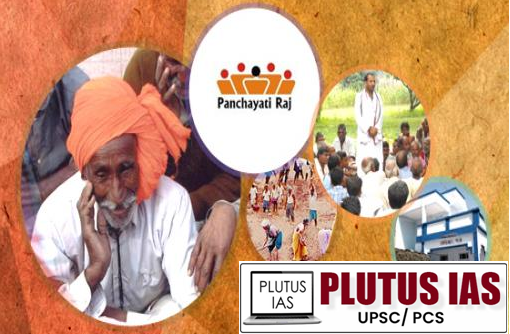22 Oct “Empowering Rural Growth through Panchayati Raj Institutions”
This article covers “Daily Current Affairs” and topic details of “Empowering Rural Growth through Panchayati Raj Institutions”
Syllabus mapping:
GS:2- Indian polity: Panchayat Raj Institution: envisaged role and actual working.
For Prelims:
Key constitutional provisions related to the PRI. Various committees and commissions related to the PRI post-independence.
For Mains:
What is the role of the PRI in rural development? What are the issues and limitations of the PRI, and ways to make PRI a real catalyst for rural development?
Why in the News?
The Ministry of Panchayati Raj is organizing a Panchayat Sammelan on “Ease of Living: Enhancing Service Delivery at the Grassroots” at the National Institute of Rural Development and Panchayati Raj (NIRD&PR), Hyderabad.

Constitutional Mandate:
Constitution (Seventy-Third Amendment) Act, 1992: This Act introduced Part IX to the Indian Constitution, establishing Panchayats as institutions of self-government in rural areas. It provided for the constitution, powers, responsibilities, and elections of Panchayats at the village, intermediate, and district levels.
Key Provisions of Part IX
1. Gram Sabha (Art. 243A): Empowered by state legislation to function at the village level.
Constitution of Panchayats (Art. 243B): Panchayats must be constituted at all three levels.
2. Composition (Art. 243C): Direct elections for members, with states empowered to legislate additional provisions.
3. Reservation of Seats (Art. 243D): Seats reserved for SCs, STs, and women.
4. Duration (Art. 243E): Panchayats have a tenure of 5 years.
5. Powers and Responsibilities (Art. 243G): Panchayats are responsible for implementing schemes for economic development and social justice, particularly related to the subjects listed in the Eleventh Schedule.
6. Finance (Art. 243H, 243I): State legislation governs taxation and funds, and Finance Commissions review the financial status of Panchayats.
7. Elections (Art. 243K): State Election Commissions supervise Panchayat elections.
8. The Eleventh Schedule of the Indian Constitution lists 29 subjects under which Panchayats may have responsibility for planning and implementing schemes related to local development.
Significance of Panchayat Raj Institutions:
Women’s participation in decision-making: Panchayats promote the inclusion of women in local governance, enhancing their role in shaping community development and local policies.
Financial provisions: Panchayats receive financial allocations to manage local resources and services, improving financial autonomy and enabling grassroots development.
Regional development (especially in tribal and backward areas): Panchayats play a crucial role in addressing the needs of underdeveloped and tribal areas, focusing on regional disparities and fostering balanced development.
Participation in policy-making: Local communities, through Panchayats, actively participate in policy formulation, ensuring that local needs and priorities are reflected in governance decisions.
People’s role in planning (Kerala’s People’s Planning Campaign): Kerala’s Janakeeya Aasoothranam is an example of how people’s involvement in planning can lead to effective local governance and inclusive development.
Role in sustainable development: Panchayats contribute to sustainable development by implementing eco-friendly and community-driven projects, as seen in villages like Gendra, Attha, and Bari Sirkiri in Madhya Pradesh.
Efficient provision of services (Water Supply in Guttakaadu Gram Panchayat): Panchayats ensure efficient delivery of essential services, such as water supply, as seen in the Guttakaadu Gram Panchayat.
Water management in Kinnigoli Gram Panchayat, Karnataka: Kinnigoli, located near Mangalore, is an example of how Panchayats manage water resources and other services to benefit rural communities.
Issues Limiting the Success of Panchayati Raj Institutions (PRIs):
Lack of mandatory financial devolution: Insufficient and irregular financial transfers from state governments hinder the Panchayats’ ability to carry out their responsibilities effectively.
Concept of the ‘Sarpanch Pati’: In many regions, male relatives of elected women representatives (commonly husbands) informally control decision-making, undermining women’s empowerment.
Irregular elections in some states: Delays and inconsistencies in holding regular Panchayat elections weaken democratic participation and governance at the grassroots level.
Unequal devolution of power across states: Different states devolve varying degrees of authority to Panchayats, creating imbalances in their functioning and limiting their overall impact.
Lack of awareness (Mani Shankar Aiyar Committee): Many rural communities remain unaware of the roles and functions of Panchayats, diminishing their involvement in local governance.
Bureaucratization: Excessive control by higher-level officials over Panchayat affairs restricts local autonomy and decision-making, hampering efficiency.
Lack of expertise in resource-rich areas: Panchayats often lack the technical knowledge and skills to manage important projects, particularly in resource-rich areas, leading to inefficiencies in utilizing local resources.
Ways to Strengthen Panchayati Raj Institutions (PRIs) for Local Governance:

Provide PRIs with adequate finances and clear functions: Ensure sufficient funds and clearly defined responsibilities for Panchayats to enable them to effectively govern at the grassroots level.
Effective use of the District Planning Committee: Strengthen the role of the District Planning Committee to coordinate and integrate local development plans with state-level priorities.
Conducting regular elections: Ensure timely and consistent Panchayat elections to maintain democratic accountability and active participation in governance.
Promote role in social development schemes: Involve Panchayats in implementing key government schemes like PM Jan Dhan Yojana and MGNREGA to boost local development and social welfare.
Utilize Digital India Mission for Awareness: Leverage digital platforms to spread awareness about the roles and functions of Panchayats, encouraging greater community involvement and participation.
Granting revenue-raising powers to Panchayats: Empower Panchayats by giving them authority to raise local revenue, enhancing their financial autonomy and reducing dependence on state governments.
Annual monitoring and evaluation: Institute regular monitoring and evaluation mechanisms to track Panchayat performance, ensuring transparency and accountability in governance.
Conduct summits and seminars: Facilitate knowledge-sharing through national and regional summits where Panchayats can exchange best practices and learn from other states’ successes.
Conclusion:
In the last three decades, the Panchayati Raj Institutions (PRIs) have seen a mix of successes and challenges. To truly transform rural governance, it is essential to strengthen these institutions from both within and through external support. Empowering PRIs will accelerate progress toward a more developed and inclusive Bharat. This transformation is crucial in achieving the vision of a “Vikshit Bharat” by 2047.
Download plutus ias current affairs (ENG) 22 Oct 2024
Prelims Question:
Q. Consider the following statements:
1. The Gram Sabha has the power to levy the tax in its jurisdiction
2. Gram Sabha consists of all members of the village who consist of the electoral college of the Panchayat.
3. The gram Sabha is the principle law law-making body of panchayat.
How many of the statements given above are correct?
A. Only one
B. Only two
C. All three
D. None
ANSWER: A
Mains Question:
The Panchayat Raj Institutions have the potential to transform the idea of rural development and good governance. In this context suggest the ways to unleash the potential of the PRI. (Answer in 250 words)




No Comments